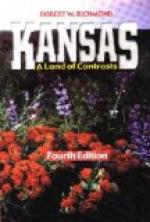An Appreciation of the American Woman
Compared to the appearance of the American girl in books written about the United States, that of Charles I.’s head in Mr. Dick’s memorial might perhaps be almost called casual. All down the literary ladder, from the weighty tomes of a Professor Bryce to the witty persiflage of a Max O’Rell, we find a considerable part of every rung occupied by the skirts appropriated to the gentler sex; and—what is, perhaps, stranger still—she holds her own even in books written by women. It need not be asserted that all the references to her are equally agreeable. That amiable critic, Sir Lepel Griffin, alludes to her only to assure us that “he had never met anyone who had lived long or travelled much in America who did not hold that female beauty in the States is extremely rare, while the average of ordinary good looks is unusually low,” and even visitors of an infinitely more subtle and discriminating type, such as M. Bourget, mingle not a little vinegar with their syrup of appreciation. But the fact remains that almost every book on the United States contains a chapter devoted explicitly to the female citizen; and the inevitableness of the record must have some solid ground of reason behind or below it. It indicates a vein of unusual significance, or at the very least of unusual conspicuousness, in the phenomenon thus treated of. Observers have usually found it possible to write books on the social and economical traits of other countries without a parade of petticoats in the head-lines. This is not to say that one can ignore one-half of society in writing of it; but if you search the table of contents of such books as Mr. Philip Hamerton’s charming “French and English,” or Mr. T.H.S. Escott’s “England: Its People, Polity, and Pursuits,” you will not find the words “woman” or “girl,” or any equivalent for them. But the writer on the United States seems irresistibly compelled to give woman all that cooerdinate importance which is implied by the prominence of capital letters and separate chapters.
This predominance of woman in books on America is not by any means a phase of the “woman question,” technically so called. It has no direct reference to the woman as voter, as doctor, as lawyer, as the competitor of man; the subject of interest is woman as woman, the Ding an sich of German philosophical slang. No doubt the writer may have occasion to allude to Dr. Mary Walker, to the female mayors of Wyoming, to the presidential ambitions of Mrs. Belva Lockwood; but these are mere adjuncts, not explanations, of the question under consideration. The European visitor to the United States has to write about American women because they bulk so largely in his view, because they seem essentially so prominent a feature of American life; because their relative importance and interest impress him as greater than those of women in the lands of the Old World, because they seem to him to embody in so eminent a measure that intangible quality of Americanism, the existence, or indeed the possibility, of which is so hotly denied by some Americans.




